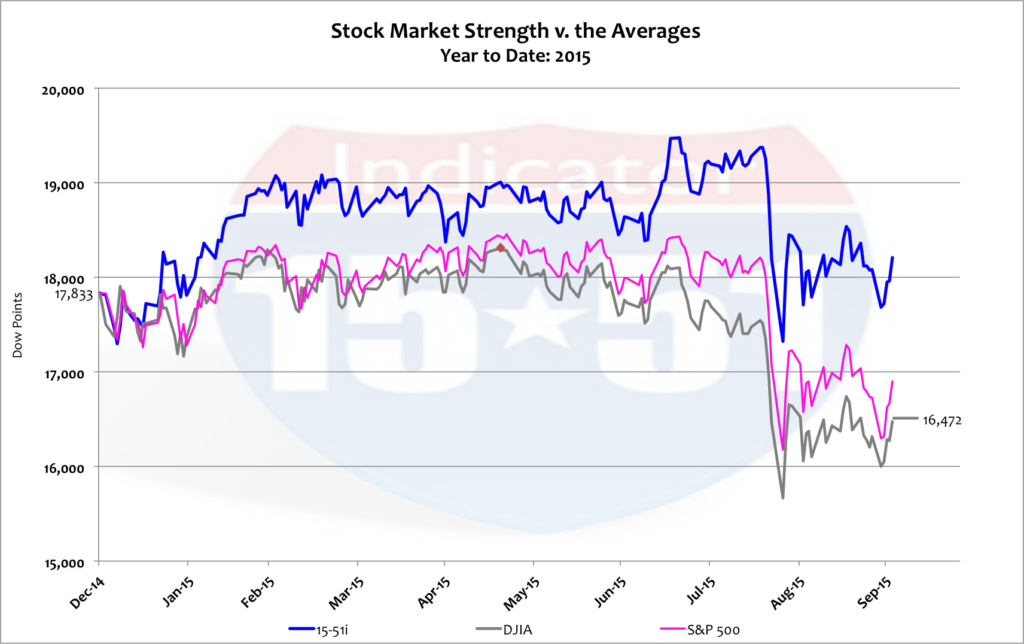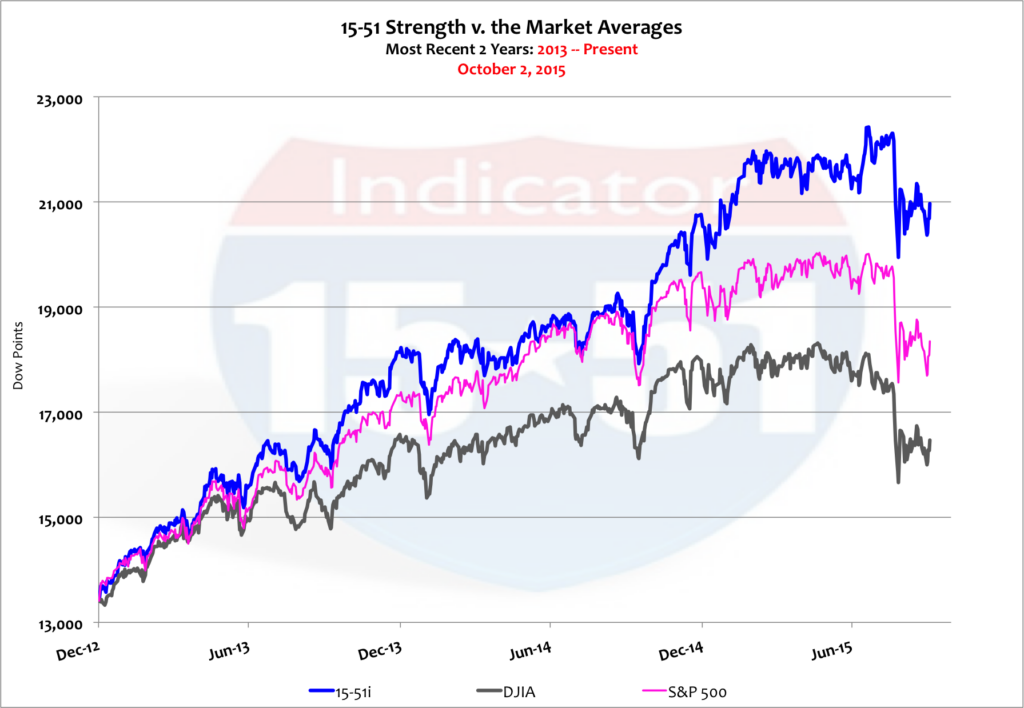Not much has changed since START SPREADING THE NEWS was posted. The U.S. economy remains weak and uneven and the stock market reflects it. The Dow Jones Industrial Average is still off 10% from its all-time high (18,312) reached on May 19, 2015. The Dow is down 8% so far this year and the S&P 500 has lost 5%. Only stock market strength is in positive territory for the year; the 15-51 Indicator is up 2%. See below.


The U.S. market is sloppy indeed — but it’s in great condition compared to the rest of the world. Take a look at these recent WSJ headlines:
- Economists React to the September Jobs Report: ‘Nothing Good to See Here’
- Flat Personal Consumption Expenditure Latest Sign of Weak Inflation
- What Do U.S. Economists Think of Official Chinese Statistics? ‘Only a Fool Would Believe Them’
- Analysis: Global Turmoil Impacts U.S. Job Growth
- Japan Sees Some Slowness in the Economy
- Eurozone Producer Prices Fall Sharply
- French Statistics Agency Forecasts 1.1% GDP Growth in 2015
- Russia Lowers Ruble (their currency) Forecast
- Fed’s Dudley: ‘A Long Way’ From Having Bubble Fighting Tool Kit
My goodness, the world is a mess. And it begins and ends with America.
President Obama came into office promising to drastically increase U.S. exports — to be accomplished, no doubt, on a weak monetary policy platform. But the rest of the world followed suit and today U.S. exports are again at the low levels experienced at the bottom of the Great Recession.
Speaker of the House John Boehner resigned and his replacement looks to be just as stupid. Heir apparent, Majority Leader Kevin McCarthy, suggested that the Benghazi and email investigations into Hillary Clinton’s performance was more about politics than it was about finding facts and protecting national security.
It’s hard to take American government seriously. (Vladimir Putin certainly doesn’t — but more on that in a bit.)
The slowdown in China shouldn’t be underestimated. It’s worse than the media’s spin and looser money polices haven’t helped. China is in a bad way, and when the global bubble bursts (which it will, of course) the world won’t be able to rely on its growth for a bailout.
Like China, both Japan and the Eurozone followed the American lead and implemented weak money policies like QE — and, as predicted in these blogs, neither effort has produced sustained economic growth and/or moderate price inflation. Remember, steadily rising prices are a sign of economic strength. Falling prices indicate weakness.
Earnings of the S&P 500 grew less than 1% in the second quarter of this year and many analysts are predicting a 3% drop in third quarter earnings. As a business owner I can corroborate that projection. My company experienced its softest quarter of growth in the third quarter since the Great Recession.
The world economy is in shambles.
Indeed, a weakening global economy will produce fewer jobs, and fewer jobs will produce less consumer spending, which of course drags down global GDP. All of that translates into weaker corporate earnings, more stock market volatility, and lower price valuations.
And none of this is to mention the status of global conflict and the weakening leadership position of the United States.
The Russian economy is a disaster, and Putin is unwilling to do what is necessary to turn it around. After all, free market policies are enemies of the State. As such, he turns to militaristic policies to build national pride and embolden his power structure. His seizure of Crimea, for instance, boosted his domestic standing substantially. And now he is making an even bolder statement in Syria.
It isn’t Russian involvement in Syria that is so striking but instead how Putin has gone about it. Under the guise of battling ISIS, he sent a three star Russian general into the U.S. Embassy in Iraq and told the Americans to remove their warplanes from Syria. In other words, get out; we are here now.
In approximately one hour after that meeting Russia began bombing positions inside Syria — and many reports indicate that initial targets were not of ISIS but instead positions of the U.S. backed rebels.
That’s Putin spitting in Obama’s eye.
A weak America is not good for the world.
Neither is an emboldened Russia.
Over the years Russia has grown closer to Syria and Iran, who by the way, have assumed a much larger role in Syria with the reinvigorated Russian presence. Iran is a largely Shiite nation. Syria, though ruled by the Shiite Assad, is largely a Sunni populous. You see, the civil war in Syria is a religious war between Muslims — Sunni and Shiite — and Russia is on the Shiite side.
The Russian attempt here is to arrest Middle Eastern influence from the U.S. and prove Russia as a more appropriate and trustworthy ally for the region.
They can succeed because the U.S. has a haphazard and confusing Middle Eastern position. Think of this…In Syria, America is supporting the Sunni’s on one hand but against the radical Sunni faction, ISIS, on the other. In other words, America is fighting against the Shiites halfheartedly. In Iraq, a largely Shiite country, America is fighting on the Shiite side along with Iranian affiliates in a fight against ISIS (Sunni). In yet another venue, American ally and major oil producer Saudi Arabia (largely Sunni) is fighting Shiites in Yemen (who are also backed by Iran) but Saudi Arabia has no legitimate U.S. support for the cause.
The Middle East, and America’s policy to it, is a total mess.
Yet oil is still just $45 a barrel, and gasoline prices are lower now than they were at the bottom of the Great Recession. Gold, too, is lower than logic would expect. But yields are on the right track for a Market environment like today. They’re still at rock bottom levels and falling. See below.


When things get scary — and investors are scared right now — there is increased demand for safe investments like U.S. Treasuries. That’s why I don’t expect U.S. yields to change significantly when the Fed finally decides to raise interest rates.
Nothing spurs more demand for U.S. bonds like an impending crisis — a crisis, by the way, that some Fed governors don’t feel capable to fight. And who could blame them? Sovereign debt is at unprecedented and unsustainable levels. During the next crisis governments won’t be able to print ungodly amounts of money and debt to leverage the economy out of recession like it did the last time — and the Fed knows it.
That’s what makes the next crash so scary. Governments won’t be able to “stimulate” the economy through massive central planning spending; and they won’t be able to keep global yields and inflation low while they fight the good fight. China won’t be able to carry the global economy out of recession with booming growth. The Euro won’t be able to survive, as major sections of the Eurozone will fail and bring about a global currency and debt devaluation. And the wars in the Middle East will expand.
Not pretty.
That’s the reason the stock market corrected so sharply in August. The environment is more risky and inching closer to major correction. That causes the stock trend to be more volatile, more dramatic, and less willing to test previous highs. See the difference below between the most recent downward correction versus all the previous ones in the most recent two years.


It looks different because it is different. It was the first salvo in the next major corrective cycle. Appreciate that — and SURVIVE THE NEXT CRASH.
Stay tuned…

